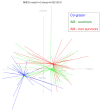Comparison of Fecal Microbiota of Horses Suffering from Atypical Myopathy and Healthy Co-Grazers
- PMID: 33672034
- PMCID: PMC7919468
- DOI: 10.3390/ani11020506
Comparison of Fecal Microbiota of Horses Suffering from Atypical Myopathy and Healthy Co-Grazers
Abstract
Equine atypical myopathy (AM) is caused by hypoglycin A (HGA) and methylenecyclopropylglycine (MCPG) intoxication resulting from the ingestion of seeds or seedlings of some Acer tree species. Interestingly, not all horses pasturing in the same toxic environment develop signs of the disease. In other species, it has been shown that the intestinal microbiota has an impact on digestion, metabolism, immune stimulation and protection from disease. The objective of this study was to characterize and compare fecal microbiota of horses suffering from AM and healthy co-grazers. Furthermore, potential differences in fecal microbiota regarding the outcome of diseased animals were assessed. This prospective observational study included 59 horses with AM (29 survivors and 30 non-survivors) referred to three Belgian equine hospitals and 26 clinically healthy co-grazers simultaneously sharing contaminated pastures during spring and autumn outbreak periods. Fresh fecal samples (rectal or within 30 min of defecation) were obtained from all horses and bacterial taxonomy profiling obtained by 16S amplicon sequencing was used to identify differentially distributed bacterial taxa between AM-affected horses and healthy co-grazers. Fecal microbial diversity and evenness were significantly (p < 0.001) higher in AM-affected horses as compared with their non-affected co-grazers. The relative abundance of families Ruminococcaceae, Christensenellaceae and Akkermansiaceae were higher (p ≤ 0.001) whereas those of the Lachnospiraceae (p = 0.0053), Bacteroidales (p < 0.0001) and Clostridiales (p = 0.0402) were lower in horses with AM, especially in those with a poor prognosis. While significant shifts were observed, it is still unclear whether they result from the disease or might be involved in the onset of disease pathogenesis.
Keywords: Lachnospiraceae; MCPA-CoA; Ruminococcaceae; equine; fecal; hypoglycin A; intestinal; intoxication; microbiome; rhabdomyolysis.
Conflict of interest statement
The authors declare no conflict of interest.
Figures




Similar articles
-
Samaras and seedlings of Acer pseudoplatanus are potential sources of hypoglycin A intoxication in atypical myopathy without necessarily inducing clinical signs.Equine Vet J. 2016 Jul;48(4):414-7. doi: 10.1111/evj.12499. Epub 2015 Oct 6. Equine Vet J. 2016. PMID: 26278545
-
Hypoglycin A Content in Blood and Urine Discriminates Horses with Atypical Myopathy from Clinically Normal Horses Grazing on the Same Pasture.PLoS One. 2015 Sep 17;10(9):e0136785. doi: 10.1371/journal.pone.0136785. eCollection 2015. PLoS One. 2015. PMID: 26378918 Free PMC article.
-
Detection of MCPG metabolites in horses with atypical myopathy.PLoS One. 2019 Feb 5;14(2):e0211698. doi: 10.1371/journal.pone.0211698. eCollection 2019. PLoS One. 2019. PMID: 30721263 Free PMC article.
-
Plants Causing Toxic Myopathies.Vet Clin North Am Equine Pract. 2024 Apr;40(1):45-59. doi: 10.1016/j.cveq.2023.11.001. Epub 2023 Dec 26. Vet Clin North Am Equine Pract. 2024. PMID: 38151404 Review.
-
Atypical myopathy: a review and description of the outbreak in the Netherlands during autumn 2009 and spring 2010.Tijdschr Diergeneeskd. 2012 Aug 1;137(8):514-21. Tijdschr Diergeneeskd. 2012. PMID: 22930982 Review.
Cited by
-
The Middle Ear Microbiota in Healthy Dogs Is Similar to That of the External Ear Canal.Vet Sci. 2023 Mar 11;10(3):216. doi: 10.3390/vetsci10030216. Vet Sci. 2023. PMID: 36977255 Free PMC article.
-
Unravelling Faecal Microbiota Variations in Equine Atypical Myopathy: Correlation with Blood Markers and Contribution of Microbiome.Animals (Basel). 2025 Jan 26;15(3):354. doi: 10.3390/ani15030354. Animals (Basel). 2025. PMID: 39943124 Free PMC article.
-
Tissue Specific Distribution and Activation of Sapindaceae Toxins in Horses Suffering from Atypical Myopathy.Animals (Basel). 2023 Jul 26;13(15):2410. doi: 10.3390/ani13152410. Animals (Basel). 2023. PMID: 37570219 Free PMC article.
References
-
- Votion D.-M., François A.-C., Kruse C., Renaud B., Farinelle A., Bouquieaux M.-C., Marcillaud-Pitel C., Gustin P. Answers to the Frequently Asked Questions Regarding Horse Feeding and Management Practices to Reduce the Risk of Atypical Myopathy. Animals. 2020;10:365. doi: 10.3390/ani10020365. - DOI - PMC - PubMed
-
- Baise E., Habyarimana J.A., Amory H., Boemer F., Douny C., Gustin P., Marcillaud-Pitel C., Patarin F., Weber M., Votion D.-M. Samaras and Seedlings of Acer Pseudoplatanus Are Potential Sources of Hypoglycin A Intoxication in Atypical Myopathy without Necessarily Inducing Clinical Signs. Equine Vet. J. 2016;48:414–417. - PubMed
Grants and funding
LinkOut - more resources
Full Text Sources
Other Literature Sources

